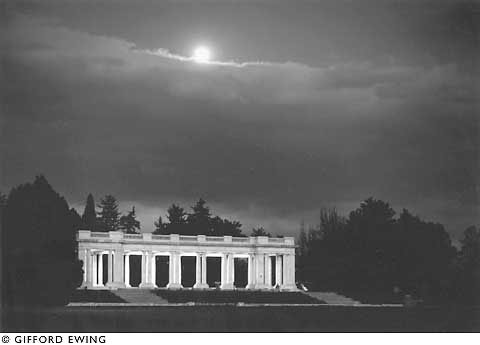8th Avenue to Colfax, Downing to Josephine
|
Transformed from a desolate city cemetery into a thriving neighborhood containing three historic districts, Cheesman Park has an interesting past! William Larimer, founder of Denver, set aside 320 acres east of the City for Mt. Prospect cemetery in 1859. Renamed City Cemetery in 1873, it was divided into three smaller graveyards—City Cemetery (80 acres), Mt. Calvary Cemetery (40 acres), and Hebrew Cemetery (10 acres). In general, the area was laden with weeds, unmarked graves, random cattle, and even, (oddly enough) some homesteaders! The lack of water also contributed to the problem. It was such an eyesore that some people refused to be buried there. When development of the city reached the edge of the cemetery, Colorado U.S. Senator Henry led the movement to change the space into a park. Questions about ownership of the area led to it having been declared federal land in 1870. He pressed Congress to allow this change in land use–their incentive? To have the park named after them! People with relatives buried in the cemetery were given 90 days to remove them once the idea of a park began to be realized. For the thousands who were either unclaimed or unable to be found, undertaker Edward P. McGovern was hired at $1.90 per person to relocate the graves. Hindered by unmarked graves, many remains were left in the cemetery during this moving process. This accounts for the many stories of hauntings around Cheesman—one of the most well known being the woman at a large home on Humboldt Street searching for her head that was left behind! Planned by Reinhard Schuetze, Denver’s first landscape architect, and finished by 1910, then named “Congress Park” was flourishing by the early 1900’s. Creation of the pavilion in the park, built with funds donated from Walter Cheesman’s widow and dedicated to the people of Denver, led to the park being renamed “Cheesman Park” in 1907. The Cheesman Park esplanade (between Williams and High Streets and 7th and 8th Avenues) connected Cheesman with the rest of the city parks system in 1912. As with other city parks, Cheesman became a center of social activity. Residential development boomed as property values soared. Building around Cheesman was most desirable because of the lack of busy streets bordering the park. Many elaborate mansions were constructed backing up to the park’s open space. However, as in neighboring Capitol Hill, development in the 1950’s and 1960’s led to the destruction of many of the finest homes in the neighborhood. Replaced by high rises that began to block Cheesman Park’s mountain views, the Cheesman Park Mountain View Ordinance was enacted in the late 1960’s to prevent further view-compromising building. Today, the Cheesman Park neighborhood includes three separate Denver Landmark Historic Districts—Wyman’s, Morgan’s, and Humboldt Island—the first residential area in Denver to be classified as a historic district. Rich with history and interesting stories, Cheesman Park is truly the heart of Denver. |
Explore Cheesman Park
Current View
Architecture
Schools
Neighborhood Associations
Information
Historic Districts
Humboldt Island
Wyman’s Historic
Morgan’s Addition

